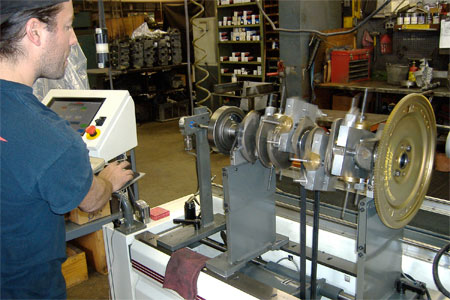
We’ve all heard (and probably used) the term “harmonic balancer.” I always get a chuckle when I hear this term used so freely by educated gear heads. Because you see, there really is no such animal as a harmonic balancer on the internal combustion engine.
The correct term is “harmonic damper.” The damper is often confused with a balancer since it is used as a balancing tool. However, in truth, you cannot balance harmonics, you can only dampen them. To understand exactly what is involved in dampening harmonics means you must first think about what is going on inside the engine.
Harmonic dampers should more correctly be termed torsional dampers. Typical diesel engines have a static compression ratio of 18:1.1 with a dynamic compression ratio of around 400 psi. The combustion process that forces the crankshaft to go around, happens in milliseconds. So the crankshaft gets hammered with an incredible torque spike. The torque spike is so severe that not only does it turn the crankshaft, but it also twists it – by as much as 1 degree. The force causing the twist on the crankshaft in a diesel engine can be as much as 10 tons.
Here is the staggering realization: this explosive twist on the crankshaft doesn’t just occur once in one cylinder, but there will be other cylinders doing the same thing within 720 degrees of rotation, the entire time the engine is running. If you could take a camera and place it in the oil pan while the engine was running, you would probably think that the crankshaft was made out of Jello.
The crankshaft is actually seeing a multiple number of torque spikes. As the rpm of the engine comes up, two or more of the torsional twists combine to form what is known as “Critical Speed.” This is where the frequencies of the twist forms a resonance that can destroy the crankshaft unless they are dampened. The crankshaft gets twisted one way and then unloads its stored energy by snapping back.
A harmonic damper can help mitigate these stresses. For maximum effectiveness it is usually placed at the front of the crankshaft, since that is where the crankshaft is the most vulnerable. The rear of the crankshaft is supported by the block and the transmission components like the flywheel or torque converter.
The damper is usually made up of an inertia ring that is molded to a hub by a piece of rubber. The damper is usually tuned by the manufacturer for each engine application and operating rpm range.
For diesel engines, these dampers live a tough life. Since diesel engines have high compression and high torque at a low rpm, more crankshaft twist is seen than with a gasoline engine. This is why the damper on a diesel engine is twice the size that of a gasoline engine. The damper on a mid-size diesel engine such as the Powerstroke, for example, can weigh around 20 lbs compared to one weighing 10 pounds on a small block Chevy.
The problem is, over a period of time, the rubber in the damper tends to wear out for much the same reason the crankshaft has problems in the first place. Let’s again examine what happens when the engine fires: the crankshaft twists, causing the torque spike. This spike travels through the crankshaft to the damper. The hub of the damper will accelerate ahead of the outer inertia ring since it is mounted in rubber.
The rubber layer and inertia ring will act to dampen the torsional spike. As the torsional spike passes, the lagging inertia ring will snap back into position. As this takes place over and over again, the damper starts to experience extreme heat. In addition to the rubber being stretched, over time, heat starts to break down the rubber causing it to harden and crack. Eventually, the damper starts to lose its effectiveness. So, torsional twist will start taking its toll on the crankshaft.
Something else you have to think about is performance. What happens when you modify your engine and begin making more power? Remember, the damper that is placed on your engine was most likely designed for the “stock” operating range. As performance increases along with rpm, so does the torsional twist. In order to maximize your stock or modified engine you should look at replacing the damper.
I believe the best way to dampen harmonics is with a viscous fluid and I prefer a damper that incorporates a heavy silicone gel. The outer housing of the damper encloses the inertia ring, which floats in this heavy silicone gel. The gel is 45,000 times more viscous than 30W motor oil. This gel is extremely stable even when subject to a wide variation of temperatures. The gel will have the same dampening effect whether it is hot or cold for the life of the engine. The gel won’t wear out or deteriorate no matter how many hours of service or what temperature environment it is exposed to.
According to Vibratech, manufacturer of the Fluidampr, the viscous gel and inertia ring allow a damper to deal with all harmonic frequencies across the engine’s entire rpm range, something a single frequency-tuned rubber ring cannot do. I consider this damper with the viscous gel as insurance, especially after installing some performance upgrades on a diesel engine. Viscous dampers are available for a wide range of internal combustion engine applications, including Caterpillar, Detroit and Cummins heavy duty diesel engine applications, from 24? to 54? in diameter.
So the next time your customer starts talking about something he THINKS he understands, be gentle with your words. Explain what’s really going on and you’ll be able to eliminate stresses on his engines and with your business relationship.













